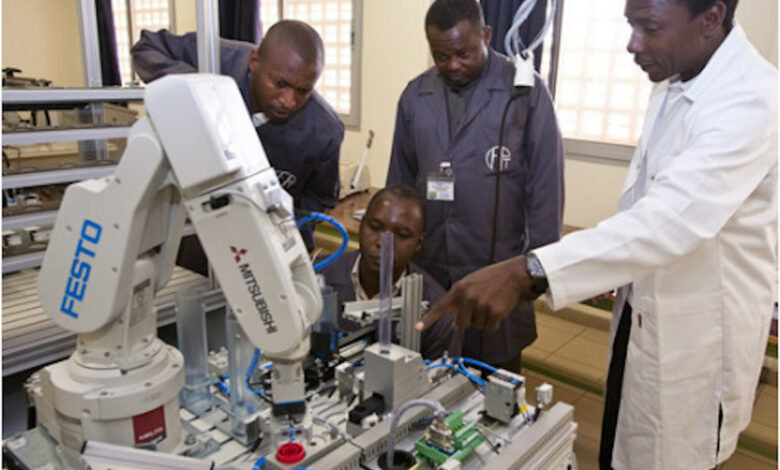China birthrate, robots to move factories to Africa

The emergence of green technology has once again put African manufacturing in the spotlight.
In February, African leaders submitted a proposal to the UN, calling for the sustainable use of minerals crucial for manufacturing “green” products, such as solar panels and batteries. The leaders argued that because these minerals are found overwhelmingly in Africa, Africa should benefit more from their exploitation, by integrating them into the continent’s industrialization.
This renewed emphasis on leveraging natural resources to industrialize only serves to highlight the failure of African manufacturing to develop on the back of mining in past decades. Africa contains half of the world’s manganese and cobalt, as well as 20% of its copper and platinum. But the vast majority of these minerals are exported unprocessed, with 85% of their processing taking place in China alone.
It is no surprise, then, that China’s manufacturing sector benefits overwhelmingly from the African minerals the country processed. Indeed, since the 1960s, African manufacturing has steadily declined as of the global total, while that of East Asia, and China in particular, increased in tandem.
On various occasions in recent years, African leaders have come together to express the need to strengthen the continent’s manufacturing by working with external partners. The Chinese government has been receptive to this call.
In particular, in August 2023, the Chinese government announced its intention to launch the Initiative on Supporting Africa’s Industrialization. This initiative provides targeted investments in African manufacturing, to help Africa diversify away from its dependence on agriculture and natural resource extraction.
Yet, this shift of manufacturing from China to Africa is happening even without the prompting of the Chinese government. Facing constraints at home and in Western markets, Chinese firms are increasingly turning to Africa to seek local market dominance. Data from August 2023 show that 12% of Africa’s manufacturing already has Chinese involvement, representing one-third of all Chinese corporate activities on the continent.
Reduced attractiveness of ‘Made in China’
One big reason for Chinese manufacturers to leave China for Africa is the rapid decline of China’s population. After losing 850,000 people in 2022 for the first decrease since 1961, the country lost another 2 million in 2023.
Projections indicate that the population will continue its dramatic decline, going from the current 1.4 billion to 1 billion in 2080, and 800 million in 2100. The country will soon not have enough consumers to continue purchasing everything made by its giant manufacturing sector, at 28% of the global total and 38% of China’s GDP.
Moreover, amid talk of Western decoupling from China-centered supply chains, fears of disrupted trade have reduced foreign enthusiasm for China-made goods. Chinese exports suffered their first decline in seven years in 2023 and missed forecasts by large margins in March 2024.
With Trump seeking a 60% tariff on all Chinese imports if he returns to the White House and the EU investigating ways to hit back on alleged Chinese dumping, the future for Chinese exports to its biggest destinations does not look bright.
With China’s population shrinking and Western efforts at decoupling intensifying, China is looking less attractive as a major base for manufacturing. For manufacturers, the status of China as a “growth” market comes under threat as the country’s working-age population continues to decline. Combined with the ongoing consumer pessimism in the country, the Chinese market for manufacturing goods may soon become a drag for the profit-focused.
China’s robotics-first manufacturing can be easily shifted to Africa
Of course, the reduced attractiveness of manufacturing inside China is not automatically a boon for manufacturing in Africa. Yes, Africa’s population may provide a large potential market for manufactured goods because it will double to 2.5 billion by 2050. But with only 1.9% of global manufacturing output today, it lacks the ready production expertise needed to attract manufacturers leaving China.
An emerging trend within Chinese manufacturing may rapidly rectify this industrial “know-how gap.”
China’s factories are rapidly shifting from labor-intensive to robot-intensive, as the number of available factory workers declines. China’s working-age population has already peaked in 2011 and the over-60 population is projected to balloon to nearly a third of the total by 2035. The remaining workers, by then, will need to work doubly hard to take care of the retired elderly and do the work they left behind.
In response to this population trend, in 2022 alone China installed more than 290,000 industrial robots, accounting for more than half of those installed around the globe. With the total stock of industrial robots growing by an average of 25% per year since 2017, China is attempting to preemptively solve the issue of future labor shortages.
A case in point is Nio, a darling of the Chinese electric vehicle industry much promoted by the Chinese government as driving the next generation of the country’s manufacturing sector. Nio has already announced its intention to reduce 30% of global headcount through technology and it has demonstrated through its second factory that 100% automation is possible.
By deploying similar robotics as the firm expands overseas beyond its factory in Hungary, it could easily enter markets like Africa that offer no production know-how but robust saless.
This advent of cheap and plentiful industrial robots means that manufacturers are less dependent on the legions of trained Chinese factory workers than they were in the past.
Suppose a sufficient portion of the Chinese industrial supply chain depends on robotics for a significant part of the manufacturing work. In that case, it is no longer inconceivable that the entire supply chain and a few “robot managers” can be shifted to Africa, a large and growing consumer market with a much brighter potential for future growth than China’s.
Made in China’s advantages less insurmountable with technology
Of course, it should be made clear that the ability to automate factories everywhere does not mean Africa will quickly replicate a manufacturing sector the size of China’s.
Even with souring consumer confidence and a shrinking population, the Chinese consumer market is the second largest in the world after the US. The country also has reliable electricity, smooth highways, fast-moving customs and efficient worker recruitment processes. These cannot be easily replicated in Africa without significant financial investment, policymaking, and changes in working culture.
But it is also worth noting that these advantages of Made in China are only a few decades old, made possible through the slow knowledge transfer and training of personnel. China exported goods worth little more than $1.5 billion in January 1981. Compare that with the nearly $300 billion worth that the country exports every month now.
As recently as 2004, China’s entire manufacturing output was a little more than 600 billion USD, a fraction of the more than 5 trillion USD today. The manufacturing growth is accompanied by the growth of China’s factory labor from as little as 53 million in 1978 to more than 200 million in 2022. In other words, China’s industrialization started at a much weaker foundation than Africa’s today.
A new industrial economy centering on automation may drastically reduce the scope for the slow process of knowledge transfer and training on humans needed for scalable manufacturing. Artificial intelligence-based software behind industrial robots can plug and play in any location in Africa with sufficient electricity and internet connections. As manufacturing’s essence shifts from relatively immovable human labor to highly mobile robots and software, the capacity for African countries to catch up with China will greatly increase.
As industrial robot fabrication and maintenance become more economical, it will be more financially viable for Chinese firms to set up automated facilities in Africa. As the Chinese consumer market shrinks and the West turns against Made in China for political reasons, exporting from automated facilities in China becomes more illogical. The Chinese, perfecting industrial robots at home, will eventually take them to Africa, helping Chinese-style automated manufacturing blossom where they do not yet exist.
Xiaochen Su, PhD, is a business risk and education consultant currently based in Malta. He previously worked in Japan, East Africa, Taiwan, South Korea and Southeast Asia.



